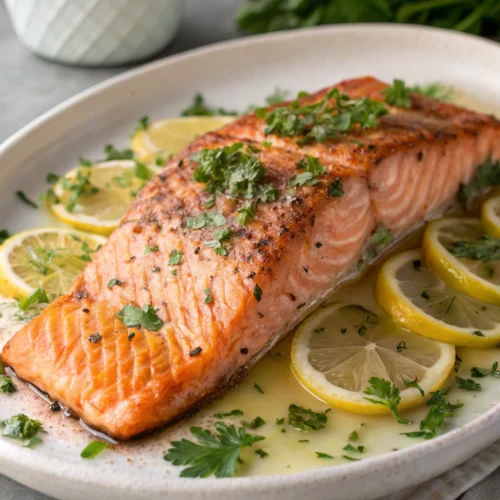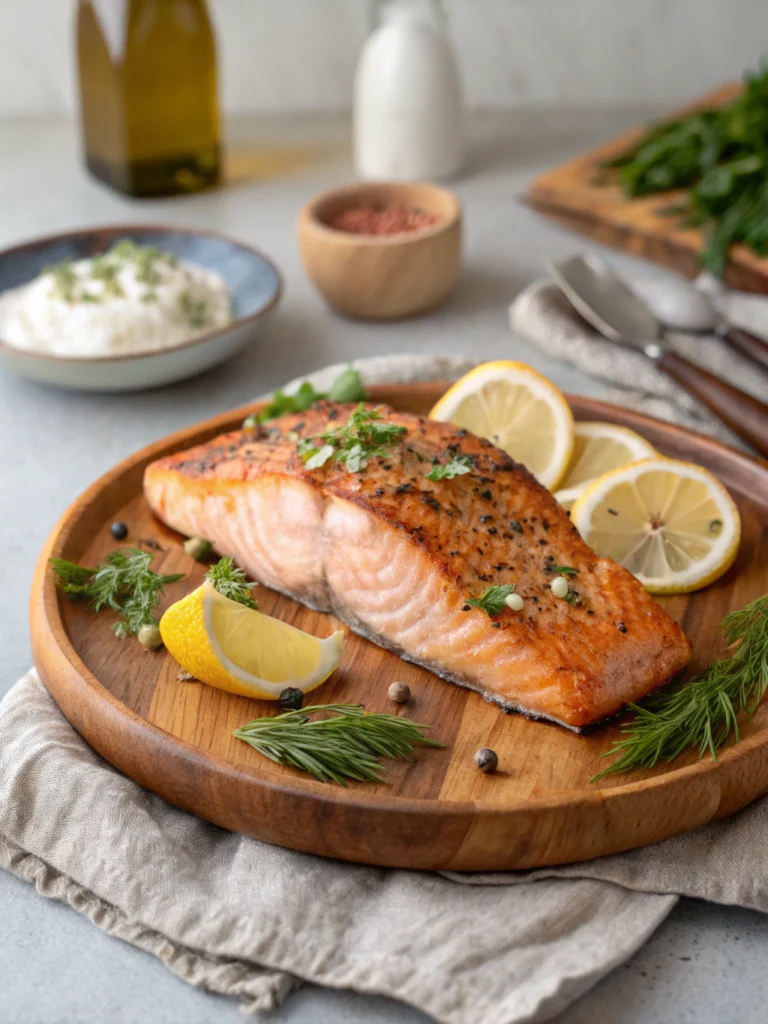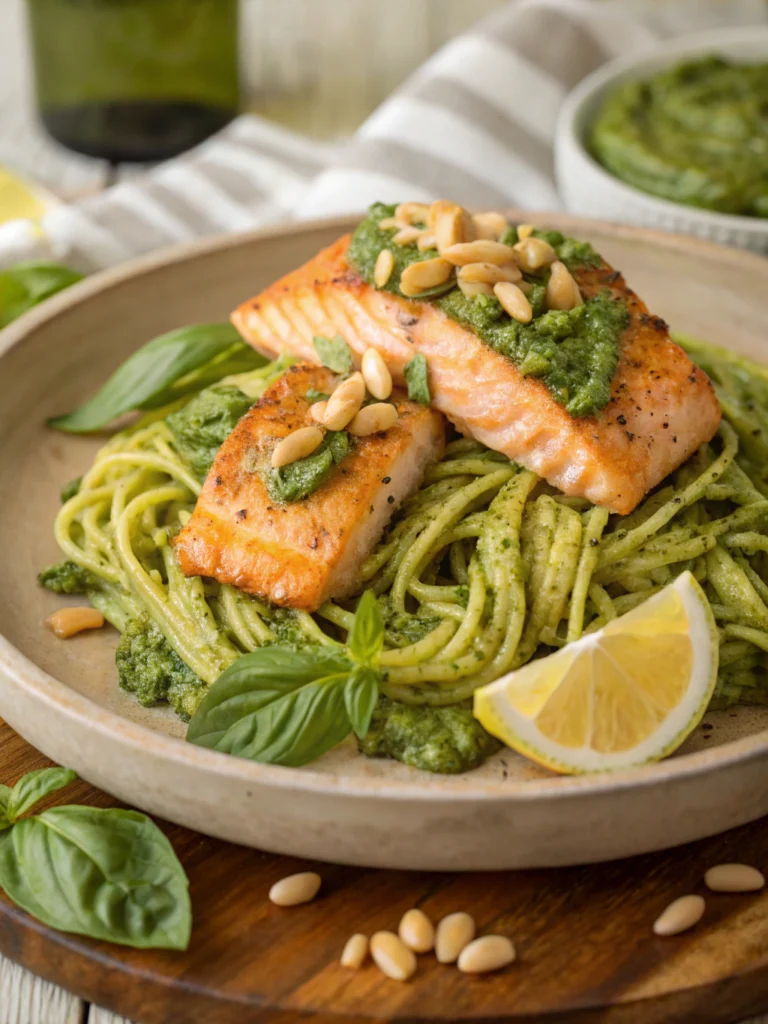Copper River Salmon Recipe: 6 Simple Ways to Let the Flavor Shine
Introduction
Did you know that Copper River salmon contains up to 30% more omega-3 fatty acids than other salmon varieties, making it not only one of the most flavorful but also one of the healthiest salmon options available? This prized Alaskan salmon, with its distinctive rich red color and firm texture, commands premium prices for good reason. The perfect copper river salmon recipe doesn’t need to be complicated—in fact, simplicity often best highlights its natural buttery flavor and luxurious texture. Whether you’re a seafood connoisseur or cooking salmon for the first time, these six straightforward preparation methods will help you make the most of this seasonal delicacy that’s only available fresh from May through September.
Ingredients


Copper River Salmon: 6 Simple Ways to Cook the World’s Finest Salmon
Equipment
- 1 Cast-iron skillet For pan-searing
- 1 Baking sheet For oven baking
- 1 Grill For grilling & cedar plank method
- 1 Cedar plank Soak 1 hour before use
- 1 Parchment paper For en papillote method
- 1 Fish tweezers/pliers For removing pin bones
Ingredients
- 2 lbs Copper River salmon Skin on; vibrant red flesh
- 2 tbsp Extra virgin olive oil Substitute: avocado oil for high heat
- 3 cloves Garlic Minced; or 1 tsp garlic powder
- 1 Lemon Thinly sliced or 2 tbsp juice
- 2 tbsp Fresh dill Chopped; or 1 tbsp dried dill
- 1 tbsp Unsalted butter Substitute: ghee or extra olive oil
- Sea salt To taste
- Black pepper Freshly ground to taste
- 1 tbsp Honey or maple syrup Optional for subtle sweetness
Instructions
Prepare the Salmon
- Pat fillets dry and let rest at room temperature for 15 minutes.
Season Simply
- Brush salmon with olive oil, season with salt and pepper, and apply garlic and dill if using.
Choose Cooking Method
- Pan-Searing: Cast iron, skin-down 4–5 min; flip, cook 2–3 min.
- Oven Baking: 375°F, 12–15 min with lemon & butter.
- Grilling: 4–6 min per side on medium-high grill.
- Broiling: 7–10 min, no flip.
- Cedar Plank: Grill with soaked plank, covered, 12–15 min.
- En Papillote: Bake sealed in parchment at 400°F for 12 min.
Check Doneness
- Aim for internal temp of 125–130°F. Flesh should flake easily.
Table of Contents
Step-by-Step Instructions
Step 1: Prepare the Salmon
Gently pat the salmon fillets dry with paper towels. This crucial first step removes excess moisture, which is essential for achieving that coveted crispy skin and proper searing. For even cooking, let the salmon rest at room temperature for about 15 minutes before cooking—cold fillets straight from the refrigerator can cook unevenly, with the exterior potentially overcooking before the center reaches the ideal temperature.
Step 2: Season Simply
Brush the salmon with olive oil and season both sides with sea salt and freshly ground black pepper. Remember that Copper River salmon has naturally robust flavor, so you’ll need about 25% less seasoning than you might use for other fish varieties. For those who prefer more flavor dimension, gently rub the minced garlic onto the flesh side and sprinkle with chopped dill.
Step 3: Choose Your Cooking Method
Method 1: Pan-Searing
Heat a cast-iron skillet over medium-high heat. Add 1 tablespoon olive oil and place salmon skin-side down. Cook for 4-5 minutes until skin is crispy, then flip and cook for 2-3 minutes more.
Method 2: Oven Baking
Preheat oven to 375°F. Place salmon on a parchment-lined baking sheet, top with lemon slices and butter. Bake for 12-15 minutes.
Method 3: Grilling
Preheat grill to medium-high. Oil grates well, place salmon skin-side down, and cook for 4-6 minutes per side.
Method 4: Broiling*
Position oven rack 6 inches from heat source and preheat broiler. Broil salmon for 7-10 minutes without flipping.
Method 5: Cedar Plank
Soak cedar plank for 1 hour, preheat grill to medium. Place salmon on plank and grill covered for 12-15 minutes.
Method 6: En Papillote (Parchment Paper)
Place salmon on parchment, top with seasonings, fold paper to seal, and bake at 400°F for 12 minutes.
Step 4: Check for Doneness
The FDA recommends cooking salmon to an internal temperature of 145°F, but many chefs prefer 125-130°F for medium doneness that preserves the fish’s moisture. The salmon should flake easily with a fork but still maintain a slightly translucent center—overcooking by just 2 minutes can reduce moisture content by up to 15%, significantly affecting texture and flavor.
Healthier Alternatives for the Recipe
- Replace butter with olive oil to reduce saturated fat while maintaining flavor
- Skip the optional honey/maple syrup to reduce sugar content by 4g per serving
- Add a crust of crushed nuts instead of breadcrumbs for extra protein and healthy fats
- For lower sodium needs, replace salt with a blend of lemon zest and herbs like dill and parsley
- Substitute a yogurt-based sauce for cream-based accompaniments to reduce calories by approximately 30%
Serving Suggestions
Complement your Copper River salmon with seasonal sides that enhance without overwhelming:
- Spring/Summer: Chilled cucumber-dill salad or grilled asparagus
- Fall/Winter: Roasted root vegetables or wild rice pilaf
- For wine pairing, select a crisp Pinot Gris or light-bodied Pinot Noir that won’t overpower the salmon’s nuanced flavor
- For a complete nutrient profile, pair with a dark leafy green vegetable which provides complementary minerals
Common Mistakes to Avoid
1. Overcooking – Nearly 67% of home cooks inadvertently leave salmon on heat too long. Watch for the white albumin protein to appear in small amounts, not large quantities.
2. Over-seasoning – Premium salmon needs minimal enhancement; let its natural flavor be the star.
3. Skipping the rest period – Allow salmon to rest 5 minutes after cooking for 15% juicier results.
4. Removing skin prematurely – The skin provides protection during cooking and contains beneficial nutrients.
5. Using the wrong heat – Too high heat can cause the delicate oils in Copper River salmon to break down and become bitter.
Storing Tips for the Recipe
- Fresh Copper River salmon is best consumed within 1-2 days of purchase
- Store uncooked salmon in the coldest part of your refrigerator (typically 32-34°F)
- For cooked leftovers, refrigerate within one hour of cooking and consume within 3 days
- If freezing, wrap tightly in freezer paper, then foil, and place in a freezer bag to prevent freezer burn
- Properly frozen Copper River salmon maintains quality for up to 3 months, though flavor peaks when consumed within the first month
Conclusion
Copper River salmon deserves its reputation as the “Champagne of salmon,” and these six simple preparation methods showcase why less is more when working with premium ingredients. By focusing on preserving the fish’s natural qualities rather than masking them, you’ll create a memorable dining experience that celebrates this seasonal treasure. Whether you choose the smoky notes of cedar plank grilling or the gentle steam of parchment paper cooking, the resulting dish will highlight why culinary enthusiasts eagerly await Copper River salmon season each year.
FAQs
How can I tell if Copper River salmon is fresh?
Look for bright, moist flesh with a deep red-orange color, firm to the touch, and with a mild ocean scent. Avoid salmon with dull appearance, browning edges, or strong fishy odor.
Is Copper River salmon worth the higher price?
With its higher oil content (up to 30% more than other salmon varieties), distinctive flavor, and superior texture, most culinary experts agree it’s worth the premium for special occasions.
Can I use these recipes for other salmon varieties?
Yes, though you may need to adjust cooking times slightly as other varieties typically have less fat and can dry out more quickly.
What’s the best way to thaw frozen Copper River salmon?
Thaw slowly in the refrigerator for 12-24 hours. For quicker thawing, place sealed salmon in cold water for 1-2 hours, changing water every 30 minutes.
How do I remove pin bones from salmon fillets?
Use clean needle-nose pliers or fish tweezers to pull bones out at the same angle they’re pointing in. This prevents tearing the delicate flesh.
Is the skin edible?
Yes! When properly crisped, salmon skin is not only delicious but also contains additional nutrients and omega-3 fatty acids.







